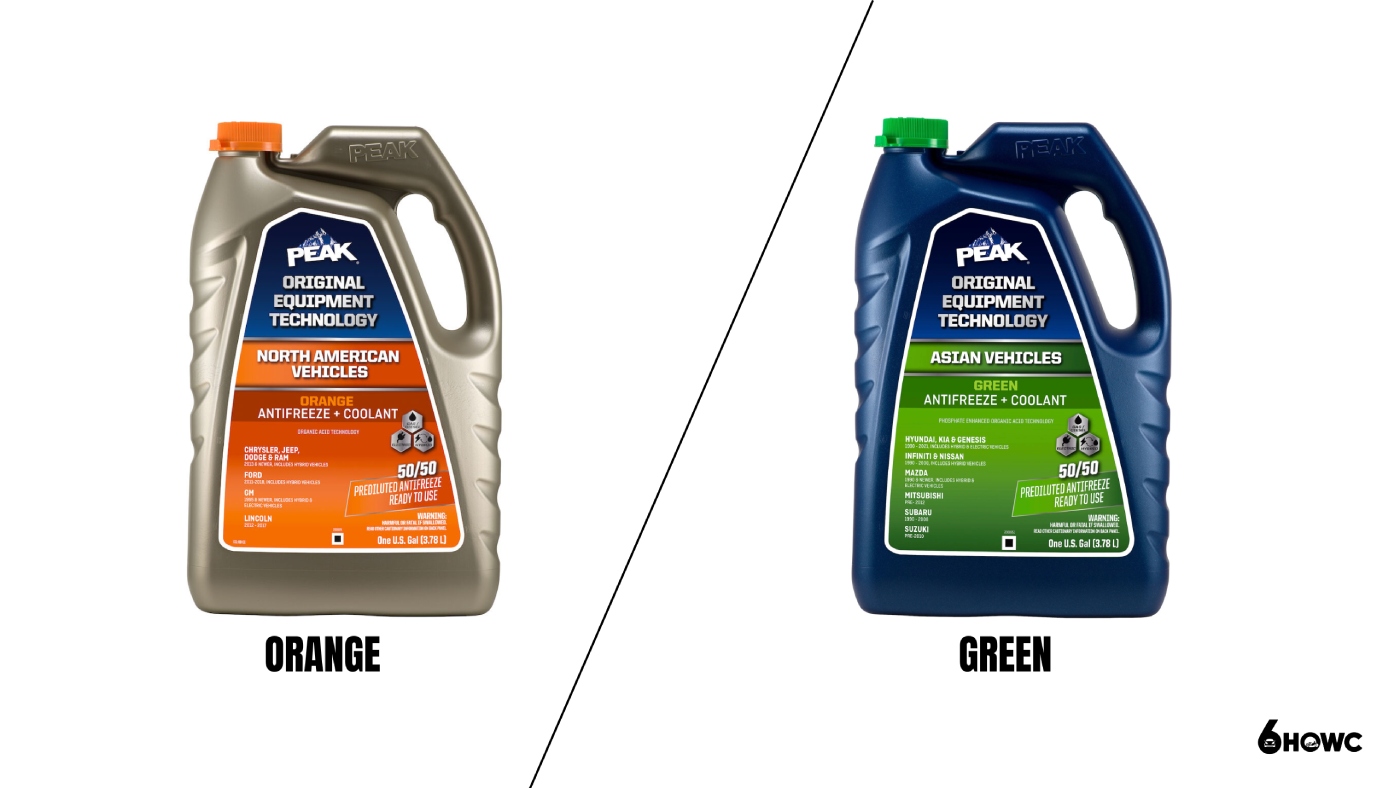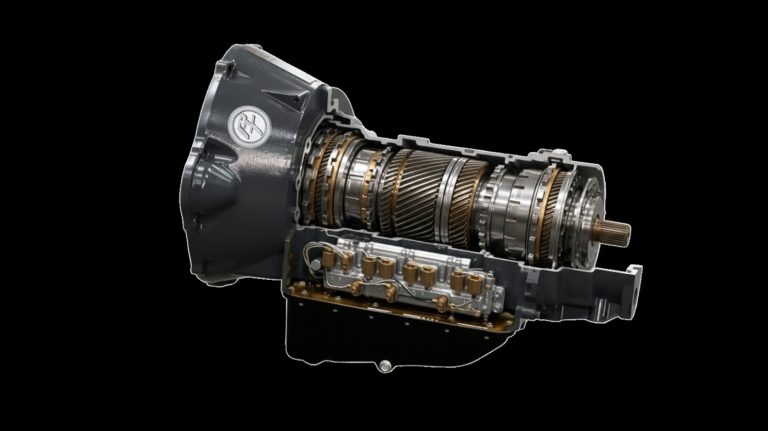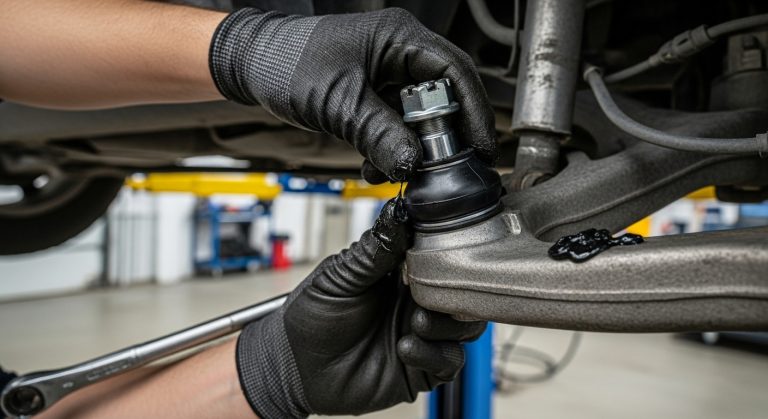When choosing antifreeze, you’ll face the orange versus green dilemma. Orange antifreeze, using Organic Acid Technology, excels in protecting modern aluminum components and lasts 3-5 years. Meanwhile, green antifreeze is best for older vehicles, containing silicates and phosphates, needing replacement every 30,000 miles. Mixing the two can lead to corrosion and clogging issues. Understanding these differences is essential for engine health. Keep exploring to uncover more about antifreeze types and their specific applications.
Key Takeaways
- Green antifreeze (IAT) is suitable for vehicles made before 2000, while orange antifreeze (OAT) is designed for newer models with aluminum components.
- Mixing green and orange antifreeze can lead to reduced effectiveness, corrosion issues, and potential engine failure due to clogging and chemical incompatibility.
- Orange antifreeze typically lasts 3 to 5 years, whereas green antifreeze lasts about 2 years and requires more frequent replacement.
- Orange antifreeze provides superior heat transfer efficiency and lower viscosity, making it better for modern engines compared to green antifreeze.
- Proper selection of antifreeze type is crucial for maintaining engine health and preventing costly repairs due to corrosion and overheating risks.
Chemical Composition of Antifreeze
Antifreeze, a critical component in vehicle cooling systems, consists primarily of ethylene glycol or propylene glycol, which effectively lowers the freezing point and raises the boiling point of the coolant.
It typically contains corrosion inhibitors like Inorganic Additive Technology (IAT) or Organic Acid Technology (OAT), tailored for different cooling systems. IAT, found in green antifreeze, employs silicates and phosphates, ideal for older vehicles. Conversely, OAT in orange antifreeze uses organic acids, providing longevity and compatibility with modern materials. Corrosion protection is essential for maintaining the integrity of engine components over time.
Common additives include dyes, foam suppressants, and pH stabilizers, enhancing performance. Antifreeze is usually mixed with water in a 50/50 ratio, optimizing thermal efficiency and protecting engine components from corrosion, cavitation, and overheating.
Vehicle Compatibility and Recommendations
When choosing the right antifreeze for your vehicle, understanding compatibility is essential to maintaining ideal performance and protecting engine components.
Green antifreeze is best suited for older vehicles, typically those made before 2000, due to their steel and copper parts. In contrast, orange antifreeze is designed for newer models with aluminum and nylon components, providing superior corrosion protection. It is important to note that different colors of antifreeze indicate specific formulas and technologies used.
If you own a vehicle requiring specific coolants like Dex-Cool, adhere strictly to those guidelines. Avoid mixing green and orange antifreeze, as it can lead to reduced effectiveness and system clogging.
Always consult your vehicle’s manual for coolant recommendations to guarantee compatibility and prevent costly repairs from potential incompatibility issues.
Lifespan and Maintenance Considerations
When comparing the lifespan of orange and green antifreeze, you’ll notice significant differences; orange antifreeze typically lasts 3 to 5 years, while green antifreeze requires replacement every 2 years. Extended life antifreeze is designed to last longer and offers protection against rust and corrosion, making it an excellent choice for your vehicle. Adhering to a strict maintenance schedule is essential, as regular flushing and level checks can greatly extend the longevity of both types. Understanding these maintenance requirements will help you maximize performance and minimize risks of overheating or corrosion.
Lifespan Comparison
While comparing the lifespans of green and orange antifreeze, it’s important to recognize the significant differences in their longevity and maintenance needs.
Green antifreeze typically lasts about 2 to 3 years or 30,000 miles, while orange antifreeze can endure for up to 5 years or 100,000 miles in newer vehicles. If you’re using an older vehicle, you can switch to orange antifreeze, but make sure the system is fully flushed beforehand. The chemical compositions also play a role; green antifreeze uses silicates and phosphates, which deplete faster, whereas orange antifreeze relies on organic acids for longer-lasting corrosion protection. Additionally, proper coolant mixture is essential for optimal engine health, so it’s crucial to maintain the recommended antifreeze-to-water ratio. Mixing the two can result in reduced effectiveness, so stick to one type to maintain peak performance and prevent potential system damage.
Maintenance Schedule Differences
To guarantee ideal engine performance and longevity, adhering to a maintenance schedule tailored to your antifreeze type is essential.
Here’s what you should focus on for both orange and green antifreeze:
- Frequency of Checks: Inspect coolant levels monthly or before long trips.
- Flush Intervals: Change coolant every two years or per manufacturer recommendations.
- Corrosion Inhibitors: Understand that orange antifreeze uses organic acids, while green relies on inorganic materials. Additionally, different antifreeze colors indicate various chemical compositions and should be considered when selecting a product.
- Hose and Radiator Inspection: Regularly check hoses for wear and ascertain the radiator is free from blockages.
Risks of Mixing Antifreeze
Mixing antifreeze types, such as green and orange, poses significant risks that can compromise your vehicle’s cooling system.
Inhibitor depletion occurs, reducing corrosion resistance, while silicate drop-out can form gel-like substances, leading to clogs in radiators and water pumps. Additionally, different mixing ratios of water and glycol can adjust freezing and boiling points according to climate, but mixing different antifreeze types disrupts this balance.
Metal contamination from mixed technologies further exacerbates corrosion issues, and glycol degradation diminishes coolant effectiveness.
The resulting acidic solution promotes corrosion, risking engine failure and costly repairs.
Additionally, inefficiencies in cooling may cause overheating and system blockages, complicating diagnosis for mechanics.
Ultimately, mixing coolants shortens lifespan and increases maintenance frequency, driving up costs.
To safeguard your engine’s health, avoid mixing different antifreeze types and adhere to manufacturer recommendations.
Cooling Performance Comparison
When comparing cooling performance, you’ll want to examine freeze protection efficiency, heat transfer capabilities, and corrosion resistance properties of both orange and green antifreeze. Each type has distinct formulations that influence how effectively they perform under extreme conditions and protect engine components. Understanding these differences can help you choose the right coolant for your vehicle’s needs. Additionally, recognizing that coolant colors are derived from specific dyes used by manufacturers can further inform your decision on which antifreeze to use.
Freeze Protection Efficiency
While both orange and green antifreeze offer freeze protection down to -34°F with a proper 50/50 water mix, their overall efficiency varies considerably due to differences in formulation and longevity.
Here’s a quick comparison:
- Longevity: Orange antifreeze typically lasts up to 5 years or 150,000 miles, while green antifreeze generally lasts only 2 to 3 years or 30,000 miles.
- Corrosion Protection: Orange antifreeze uses organic acid technology for superior corrosion protection in modern engines, making it compatible with all coolant technologies.
- Boil-Over Protection: Both types handle boil-over protection up to 265°F effectively.
- Compatibility: Orange is ideal for newer vehicles, while green suits older models but can cause issues with aluminum components.
Choosing the right antifreeze is vital for ideal engine performance and longevity.
Heat Transfer Capabilities
Understanding the heat transfer capabilities of orange and green antifreeze is essential for optimizing engine performance. Orange coolants, designed for modern aluminum engines, often outperform green coolants in heat transfer efficiency due to their superior thermal conductivity and lower viscosity. Ethylene glycol’s properties enhance cooling performance, particularly in high-performance scenarios. However, mixing green and orange coolants can lead to corrosion and reduced efficiency, making it crucial to choose the right type for your vehicle.
| Property | Orange Antifreeze | Green Antifreeze |
|---|---|---|
| Thermal Conductivity | Higher | Lower |
| Viscosity | Less viscous | More viscous |
| Engine Compatibility | Best for aluminum engines | Best for older engines |
Both types provide boil-over protection, but orange antifreeze guarantees longer service life and better cooling efficiency in newer vehicles. Consider your engine type when choosing the appropriate coolant.
Corrosion Resistance Properties
Corrosion resistance properties are vital for guaranteeing the longevity and performance of your vehicle’s engine, as different antifreeze formulations offer varying levels of protection.
Here’s how orange and green antifreeze compare:
- Green Antifreeze: Contains silicates and phosphates, effective for vehicles made before 2000, but less effective for modern materials.
- Maintenance: Green antifreeze requires flushing every three years or 36,000 miles, whereas orange antifreeze lasts longer. Some manufacturers use unique colors unrelated to formula type.
- Corrosion Protection: Green antifreeze protects older metals like steel and copper, while orange antifreeze, using Organic Acid Technology, safeguards newer components such as aluminum.
- Compatibility: Confirm you select the antifreeze suited for your vehicle’s age to prevent corrosion and maintain peak cooling performance.
Choosing the right antifreeze type is vital for protecting your engine’s integrity.
Safety and Cost Implications
Mixing green and orange antifreeze can pose significant safety and cost risks that you should be aware of. The chemical incompatibility results in acidic solutions, leading to corrosion of engine components. This mixture can also create a gel-like substance that clogs the cooling system, risking engine failure due to overheating.
Additionally, using different types of coolant can compromise the protective qualities of the antifreeze, increasing the likelihood of engine damage. In addition, the loss of corrosion protection increases maintenance and repair costs, as the coolant’s lifespan diminishes, necessitating more frequent changes.
Attempting to save money by mixing antifreeze can backfire, leading to expensive repairs. Flushing the system to restore proper coolant types incurs additional costs, while using the correct antifreeze guarantees long-term savings by extending component life and preventing premature wear. Choose wisely to avoid costly consequences.
Frequently Asked Questions
Can I Use Orange Antifreeze in Older Vehicles?
You shouldn’t use orange antifreeze in older vehicles.
It’s formulated for modern engines, particularly those with aluminum components, utilizing Organic Acid Technology (OAT) for corrosion protection.
Older vehicles typically rely on Inorganic Additive Technology (IAT) found in green antifreeze.
Mixing these coolants can lead to chemical incompatibilities, potentially causing engine damage and cooling system issues.
Always refer to your vehicle’s manual to guarantee you’re using the appropriate coolant for peak performance and longevity.
What Happens if I Accidentally Mix Antifreeze Types?
If you accidentally mix antifreeze types, you’re inviting trouble into your engine’s cooling system.
You’ll likely create a thick, gel-like substance that clogs radiators and disrupts efficient cooling, risking overheating. The acidic solution formed can corrode engine components, leading to costly repairs and even engine failure.
To avoid this mess, you should always flush the system and use compatible coolants according to your manufacturer’s specifications for peak performance and longevity.
How Can I Tell What Coolant Is in My Vehicle?
To identify the coolant in your vehicle, check the color first; green often indicates Inorganic Acid Technology (IAT), while orange suggests Organic Acid Technology (OAT).
Inspect the owner’s manual for specific recommendations. If you’re uncertain, contact your dealership for guidance or use online coolant lookup tools based on your vehicle’s make and model.
Always verify the coolant type by reading the label on the container before any maintenance work.
Are There Universal Antifreeze Options Available?
Yes, there are universal antifreeze options available that claim compatibility with most vehicles.
These formulations combine various technologies to accommodate different cooling systems. While you can use them temporarily, they’re not recommended for long-term application due to potential incompatibility issues.
Universal antifreeze provides corrosion and scale protection, similar to specific types, but always check your vehicle’s manual to verify it meets the required standards for your specific engine and cooling system.
Does Antifreeze Expire or Lose Effectiveness Over Time?
Antifreeze is like a clock, ticking down its effectiveness over time. Yes, antifreeze does expire and loses its protective qualities.
Unopened, it can last 2 to 5 years, but once opened, you’re typically looking at less than a year. Factors like exposure to air, temperature fluctuations, and contamination can accelerate degradation.
Regular checks for discoloration, foul odors, or sediment can help you determine if it’s time to replace your antifreeze.
Antifreeze Done Right: Ensuring Smooth Rides and Engine Health
In the domain of antifreeze, orange and green symbolize more than just color; they represent distinct chemical philosophies. Choosing the right type is essential for your vehicle’s longevity and performance, akin to selecting the right fuel for a fire. By respecting their unique compositions and compatibility, you guarantee your engine runs smoothly, avoiding the risks of mixing and the potential for costly repairs. Ultimately, understanding these differences safeguards your vehicle, allowing it to thrive in the harshest conditions.




